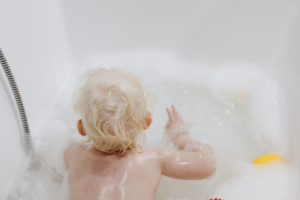Bedwetting
January 22, 2024Secondary Drowning and Dry Drowning –What are they and do I need to worry?
January 22, 2024Childproofing the Bathroom: Essential Steps to Ensure Pediatric Safety
As parents, guardians, or caregivers, ensuring the safety of our children is paramount. While we often focus on childproofing our homes, one area that requires special attention is the bathroom. The bathroom, with its numerous potential hazards, poses a significant risk to young children. From slips and falls to scalding water, medication mishaps, and electrical dangers, the bathroom can be an accident-prone zone if not properly childproofed.
Importance of Supervision
Supervision is important when it comes to ensuring the safety of young children in the bathroom. Young kids are naturally curious and may not fully understand the potential dangers lurking in this space. They can easily find themselves in hazardous situations from slips and falls to accessing harmful substances or drowning risks. It is crucial to recognize that even a moment of inattention can lead to accidents. By maintaining vigilant supervision, caregivers can swiftly intervene, mitigate risks, and provide a safe environment for children to explore and maintain their well-being.

Water Temperature: is a crucial aspect of childproofing the bathroom, as scalding from hot water can cause severe burns and injuries. It is essential to regulate the water temperature in your home. Installing anti-scald devices such as thermostatic mixing valves or anti-scald shower heads can help prevent water from reaching dangerous temperatures. Additionally, guidance on setting the water heater temperature is vital. The recommended temperature is usually 120 degrees Fahrenheit (49 degrees Celsius) or lower to minimize the risk of scalding incidents.
Slips and Falls: pose a significant risk with slippery surfaces and potential obstacles, accidents can happen in an instant. It’s crucial to address this hazard by implementing preventive measures. One effective strategy is to place non-slip mats or rugs on the bathroom floor to provide better traction. Additionally, installing grab bars near the toilet, bathtub, and shower can offer valuable support and stability.
Equally important is the need to keep bathroom floors dry and clutter-free. A wet floor can be treacherous, particularly for little ones with less developed balance and coordination. After every use, make sure to dry the floor thoroughly to prevent slips. Encourage family members to wipe their feet before entering the bathroom and provide a designated spot for towels or robes to avoid unnecessary clutter.
Medication and Toiletry Storage
The bathroom often houses a variety of medications and toiletries, posing potential hazards to curious children. From prescription medications to cleaning products and personal care items, these substances can be harmful if accessed unsupervised. Therefore, it is crucial to prioritize the safe storage of medications and toiletries to protect children from accidental ingestion or exposure. Storing them out of children’s reach is of utmost importance, whether it’s on high shelves, locked cabinets, or in dedicated storage containers. Child-resistant containers and cabinets can provide an extra layer of protection, making it more difficult for children to access potentially harmful substances.
Electrical Appliances: can pose a significant risk of electrical shock if not handled and stored properly. The combination of water and electricity creates a dangerous environment that demands our utmost attention. To begin, it is essential to highlight the risk of electrical shock from appliances in the bathroom. Water conducts electricity, and a momentary lapse in judgment or accidental splashing can result in a severe injury. Therefore, keeping all electrical appliances away from water sources is important. Ensure that outlets and switches are properly installed, away from sinks, bathtubs, and showers, to minimize the risk of water contact.
Additionally, we must discuss the safe usage and storage of electrical appliances. When using appliances in the bathroom, such as hairdryers, electric razors, or curling irons, always ensure that they are dry and free from any water residue before plugging them in. It is crucial to unplug these appliances after use and store them in a safe, dry location, away from the reach of children. This not only prevents potential accidents but also helps extend the lifespan of the appliances.
Other Hazards
The bathroom harbors various other potential hazards that demand attention to ensure the safety of children. One such concern involves sharp objects that can cause cuts or injuries. Razors, scissors, or even broken glass can pose a significant risk. It is crucial to store these items out of reach, in secure cabinets or drawers, to prevent curious hands from accessing them.
Another hazard that warrants consideration is the risk of drowning, particularly in bathtubs or toilets. Young children can be drawn to water, and even a small amount can pose a serious threat. Installing toilet seat locks can prevent accidental drowning incidents, while constant supervision during bath time is essential to ensure the child’s safety.
Childproofing the bathroom is an essential step in ensuring the safety of our little ones. It is crucial for parents and caregivers to be proactive in childproofing the bathroom. Implementing practical tips and guidelines significantly reduces the risk of accidents. By remaining vigilant and attentive, we can protect our children from harm and provide them with a safe environment for their personal care routines.
